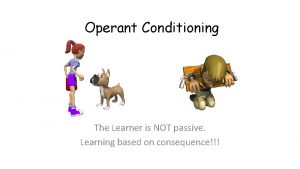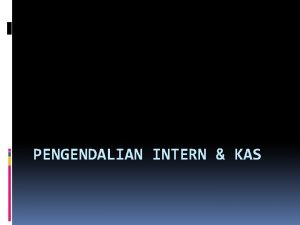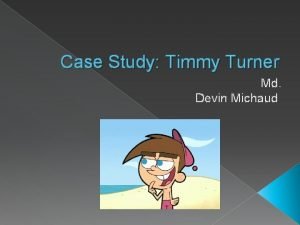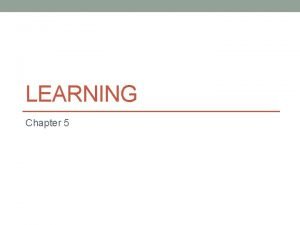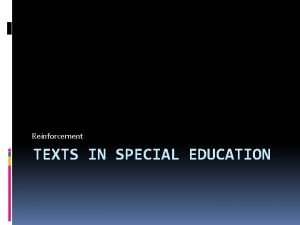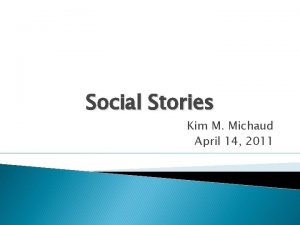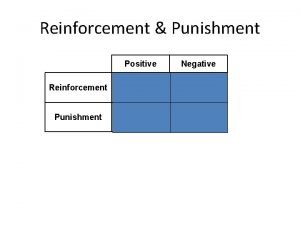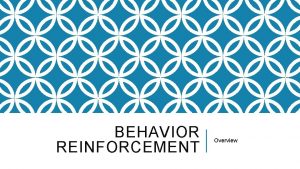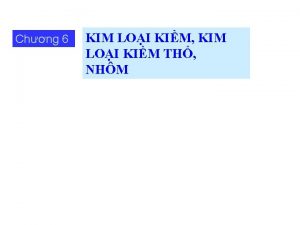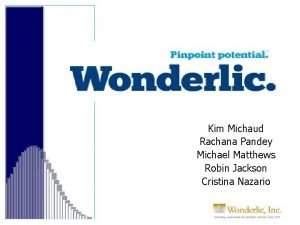Positive Reinforcement Kim Michaud April 21 2011 Positive








- Slides: 8

Positive Reinforcement Kim Michaud April 21, 2011

• Positive consequences reinforce desired behavior – Tangible – can see, hold, and understand as a reward – Social – acknowledge appropriate behavior or goal achievement – Activities – privilege earned for desired behavior – Intrinsic – the individual is self-rewarded for meeting a goal/performing behavior


PBIS School-wide Acknowledgement Matrix (Student and Staff!) TYPE Immediate/High Frequency In the moment, predictable (e. g. , Gotchas, Paws, High Fives) WHAT WHEN KIDS: High frequency for a short time when first teaching desired behavior or re-teaching identified problem behavior from data ALL KIDS, ALL STAFF At least monthly ALL KIDS. ALL STAFF Maintaining a taught behavior (fading) ALL KIDS, ALL STAFF At least quarterly ALL KIDS, ALL STAFF ADULTS: Redemption of high frequency (e. g. , school store, drawings) KIDS: WHERE WHO ADULTS: Intermittent/Unpredictable (e. g. , surprise homework completion treat, random use of gotchas in hallway) Long-term School-wide Celebrations (school-wide not individually based) FOR: Ex: ODR reduction, school-wide target met for certain setting/behavior area ACTIVITY: (e. g. , ice cream social, dance, game day) KIDS: ADULTS: BOTH TOGETHER:

• Over time, move from: – Other-delivered to self-delivered (extrinsic vs. intrinsic motivation) – Highly frequent to less frequent – Predictable to unpredictable – Tangible to social • Individualize for students needing greater support systems

Self-Monitoring • Student(s) agrees to keep track • Develop easy tally or tracking system • Instructor and student validate

References Gable, R. , Hester, P. , Rock, M. , & Hughes, K. (2009). Back to basics: Rules, praise, ignoring, and reprimands revisited. Intervention in School and Clinic, 44(4), 195 -205. doi: 10. 1177/1053451208328831 Gable, R. A. , Quinn, M. M. , Rutherford, B. B. , Howell, K. W. , Hoffman, C. C. (2000). Addressing Student Problem Behavior – Part III: Creating Positive Behavioral Intervention Plans and Supports [Monograph]. Retrieved from http: //cecp. air. org/fba The IRIS Center for Training Enhancements. (2009 b). Who’s in Charge? Developing a Comprehensive Behavior Management System. Retrieved on February 6, 2011 from http: //iris. peabody. vanderbilt. edu/parmod/chalcycle/ htm

References The IRIS Center for Training Enhancements. (2008). SOS: Helping students become independent learners. Retrieved on February 2, 2011 from http: //iris. peabody. vanderbilt. edu/sr/chalcycle. h tm Technical Assistance Center on Positive Behavioral Interventions and Supports. http: //www. pbis. org Scheuermann, B. K. & Hall, J. A. (2008). Positive behavioral supports for the classroom. Upper Saddle River, NJ: Pearson Education, Inc.
